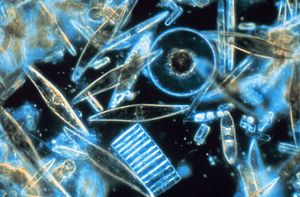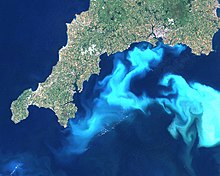Phytoplankton: Difference between revisions
Rescuing 1 sources and tagging 0 as dead. #IABot (v1.6.1) (Balon Greyjoy) |
|||
| Line 106: | Line 106: | ||
* [http://vimeo.com/84872751/ Ocean Drifters], a short film narrated by David Attenborough about the varied roles of plankton |
* [http://vimeo.com/84872751/ Ocean Drifters], a short film narrated by David Attenborough about the varied roles of plankton |
||
* [http://www.planktonchronicles.org/en Plankton Chronicles], a short documentary films & photos |
* [http://www.planktonchronicles.org/en Plankton Chronicles], a short documentary films & photos |
||
* [http://saga.pmel.noaa.gov/review/dms_climate.html DMS and Climate], NOAA |
* [https://web.archive.org/web/20150214081038/http://saga.pmel.noaa.gov/review/dms_climate.html DMS and Climate], NOAA |
||
* [http://planktonnet.awi.de/ Plankton*Net], images of planktonic species |
* [http://planktonnet.awi.de/ Plankton*Net], images of planktonic species |
||
Revision as of 11:58, 5 December 2017

Phytoplankton
Ecology
Phytoplankton are
Phytoplankton obtain
The effects of
While almost all phytoplankton
The term phytoplankton encompasses all photoautotrophic microorganisms in aquatic
In terms of numbers, the most important groups of phytoplankton include the
Minerals
Phytoplankton are crucially dependent on
Vitamin B
Phytoplankton depend on
Oxygen production
Phytoplankton absorb energy from the Sun and nutrients from the water to produce their own food. In the process of photosynthesis, phytoplankton release molecular oxygen (O
2) into the water. It is estimated that between 50% and 85% of the world's oxygen is produced via phytoplankton photosynthesis.[16][17][18][19] The rest is produced via photosynthesis on land by plants.[17] Furthermore, phytoplankton photosynthesis has controlled the atmospheric CO
2/O
2 balance since the early Precambrian Eon.[20] (See Biological pump.)
Growth strategy
In the early twentieth century, Alfred C. Redfield found the similarity of the phytoplankton’s elemental composition to the major dissolved nutrients in the deep ocean.[21] Redfield proposed that the ratio of nitrogen to phosphorus (16:1) in the ocean was controlled by the phytoplankton’s requirements which subsequently release nitrogen and phosphorus as they are remineralized. This so-called “Redfield ratio” in describing stoichiometry of phytoplankton and seawater has become a fundamental principle to understand the marine ecology, biogeochemistry and phytoplankton evolution.[22] However, Redfield ratio is not a universal value and it may diverge due to the changes in exogenous nutrient delivery[23] and microbial metabolisms in the ocean, such as nitrogen fixation, denitrification and anammox.
The dynamic stoichiometry shown in unicellular algae reflects their capability to stockpile nutrients in internal pool, shift between enzymes with various nutrient requirements and alter osmolyte composition.[24][25] Different cellular components have their own unique stoichiometry characteristics,[22] for instance, resource (light or nutrients) acquisition machinery such as proteins and chlorophyll contain high concentration of nitrogen but low in phosphorus. Meanwhile, growth machinery such as ribosomal RNA contains high nitrogen and phosphorus concentration.
Based on allocation of resources, phytoplankton is classified into three different growth strategies, namely survivalist, bloomer[26] and generalist. Survivalist phytoplankton has high ratio of N:P (>30) and contains numerous resource-acquisition machinery to sustain growth under scarce resources. Bloomer phytoplankton has low N:P ratio (<10), contains high proportion of growth machinery and adapted to exponential growth. Generalist phytoplankton has similar N:P to Redfield ratio and contain relatively equal resource-acquisition and growth machinery.
Environmental controversy
A 2010 study published in Nature reported that marine phytoplankton had declined substantially in the world's oceans over the past century. Phytoplankton concentrations in surface waters were estimated to have decreased by about 40% since 1950, at a rate of around 1% per year, possibly in response to
Estimates of oceanic phytoplankton change are highly variable. One global ocean primary productivity study found a net increase in phytoplankton, as judged from measured chlorophyll, when comparing observations in 1998–2002 to those conducted during a prior mission in 1979–1986.[34] However, using the same database of measurements, other studies concluded that both chlorophyll and primary production had declined over this same time interval.[35][36] The airborne fraction of CO2 from human emissions, the percentage neither sequestered by photosynthetic life on land and sea nor absorbed in the oceans abiotically, has been almost constant over the past century, and that suggests a moderate upper limit on how much a component of the carbon cycle as large as phytoplankton have declined.[37] In the northeast Atlantic, where a relatively long chlorophyll data series is available, and the site of the Continuous Plankton Recorder (CPR) survey, a net increase was found from 1948 to 2002.[38] During 1998–2005, global ocean net primary productivity rose in 1998, followed by a decline during the rest of that period, yielding a small net increase.[39] Using six climate model simulations, a large multi-university study of ocean ecosystems predicted that "a global increase in primary production of 0.7% at the low end to 8.1% at the high end," by 2050 although with "very large regional differences" including "a contraction of the highly productive marginal sea ice biome by 42% in the Northern Hemisphere and 17% in the Southern Hemisphere."[40] A more recent multi-model study estimated that primary production would decline by 2-20% by 2100 A.D.[7] Despite substantial variation in both the magnitude and spatial pattern of change, the majority of published studies predict that phytoplankton biomass and/or primary production will decline over the next century.[6][41][42][43][44][45][46][47][48]
Researchers at the Woods Hole Oceanographic Institution have found phytoplankton to be a major source of methanol (CH
3OH) in the ocean in quantities that could rival or exceed that which is produced on land.[49][50]
Aquaculture
Phytoplankton are a key food item in both
The production of phytoplankton under artificial conditions is itself a form of aquaculture. Phytoplankton is cultured for a variety of purposes, including foodstock for other aquacultured organisms,
See also
- Algae
- Algae culture
- AlgaeBase
- Bacterioplankton
- Biological pump
- CLAW hypothesis
- Cyanobacteria
- Iron fertilization
- Microphyte(microalgae)
- Ocean acidification
- Paradox of the plankton
- Photosynthetic picoplankton
- Plankton
- Zooplankton
References
- ISBN 978-1-4288-3314-2.[page needed]
- ^ Ghosal; Rogers; Wray, S.; M.; A. "The Effects of Turbulence on Phytoplankton". Aerospace Technology Enterprise. NTRS. Retrieved 16 June 2011.
{{cite web}}: CS1 maint: multiple names: authors list (link) - ^ Michael J. Behrenfeld; et al. (30 March 2001). "Biospheric primary production during an ENSO transition". Science. 291 (5513): 2594. Retrieved 3 August 2017.
{{cite journal}}: Explicit use of et al. in:|author2=(help) - ^ "NASA Satellite Detects Red Glow to Map Global Ocean Plant Health" NASA, 28 May 2009.
- ^ "Satellite Sees Ocean Plants Increase, Coasts Greening". NASA. 2 March 2005. Retrieved 9 June 2014.
- ^ doi:10.5194/bg-7-621-2010.)
{{cite journal}}: CS1 maint: unflagged free DOI (link - ^ doi:10.5194/bg-7-979-2010.)
{{cite journal}}: CS1 maint: unflagged free DOI (link - ISBN 978-92-3-103871-6.
- doi:10.1086/282171.
- doi:10.1038/326655a0.
- PMID 22129724.
- .
- ^ Richtel, M. (1 May 2007). "Recruiting Plankton to Fight Global Warming". New York Times.
- doi:10.2307/4018225.
- ^ Wall, Tim. "Vitamin Deserts Limit Marine Life". Discovery News.
- ^ "How much do oceans add to world's oxygen?". Earth & Sky. 8 June 2015. Retrieved 4 April 2016.
- ^ a b Roach, John (7 June 2004). "Source of Half Earth's Oxygen Gets Little Credit". National Geographic News. Retrieved 4 April 2016.
- ^ Biological Sciences: Is the World's Oxygen Supply Threatened? JH Ryther - Nature, 1970 - Springer
- . Retrieved 4 April 2016.
- OCLC 13993674.
- ^ PMID 16163345.
- doi:10.1038/339460a0.
- ISBN 978-0-691-07491-7.[page needed]
- .
- PMID 15141209.
- PMID 20671703.
- .
- PMID 21490623.
- ^ PMID 21490624.
- PMID 21490625.
- .
- ^ "Secchi Disk Study".
- .
- .
- .
- .
- .
- PMID 17151666.
- .
- .
- .
- doi:10.5194/bg-10-2711-2013.)
{{cite journal}}: CS1 maint: unflagged free DOI (link - PMID 24143135.)
{{cite journal}}: CS1 maint: unflagged free DOI (link - .
- .
- PMID 19075222.
- PMID 11089968.
- ^ "Major Source of Methanol in the Ocean Identified". Woods Hole Oceanographic Institution. 10 March 2016. Retrieved 30 March 2016.
- PMID 26963515.)
{{cite journal}}: CS1 maint: unflagged free DOI (link - ^ a b c d McVey, James P., Nai-Hsien Chao, and Cheng-Sheng Lee. CRC Handbook of Mariculture Vol. 1 : Crustacean Aquaculture. New York: C R C P LLC, 1993.[page needed]
Further reading
- Greeson, Phillip E. (1982). An annotated key to the identification of commonly occurring and dominant genera of Algae observed in the Phytoplankton of the United States. Washington, D.C.: United States Government Printing Office. ISBN 978-0-607-68844-3.
- Kirby, Richard R. (2010). Ocean Drifters: A Secret World Beneath the Waves. Studio Cactus. ISBN 978-1-904239-10-9.
- Martin, Ronald; Quigg, Antonietta (2013). "Tiny Plants That Once Ruled the Seas". Scientific American. 308 (6): 40–5. PMID 23729069.
External links
- Secchi Disk and Secchi app, a citizen science project to study the phytoplankton
- Ocean Drifters, a short film narrated by David Attenborough about the varied roles of plankton
- Plankton Chronicles, a short documentary films & photos
- DMS and Climate, NOAA
- Plankton*Net, images of planktonic species




